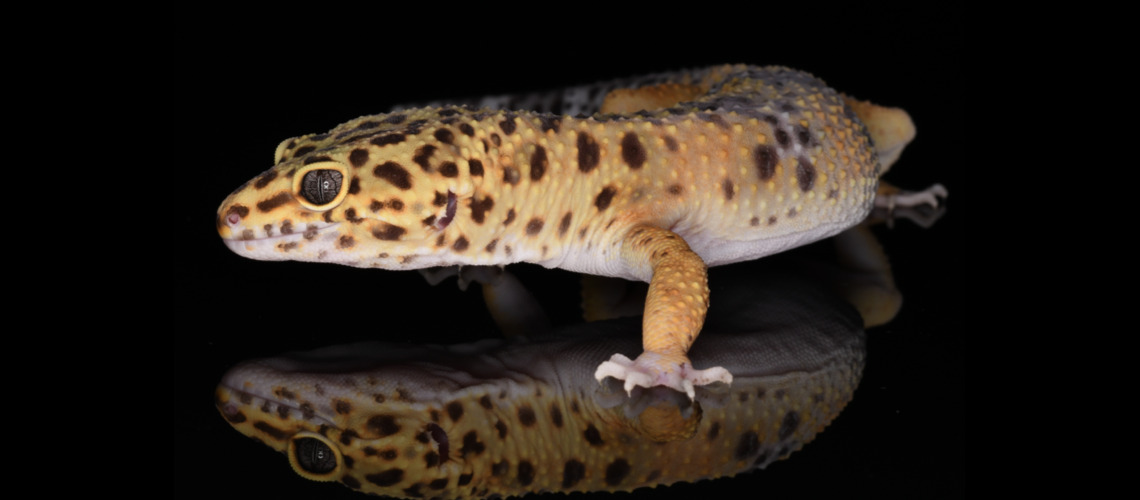From bands to spots, the secrets of the leopard gecko’s skin
Two biologists from UNIGE determined how bands and then spots are formed on the skin of the leopard gecko.

During the first few months of its life, the leopard gecko displays banded patterns. Once adult, these give way to black spots, reminiscent of the leopard’s coat. © LANEVOL
While the patterns and colours of lizards’ skin are fascinating, the mechanisms behind them are largely unknown. A team from the University of Geneva (UNIGE) studied the leopard gecko, a popular lizard, to understand how the bands on the skin of juveniles turn into spots when they reach adulthood. Their work reveals that this transition is orchestrated by the interactions between different pigment cells, offering new insights into the biology of pigmentation in reptiles. These results are published in the journal Proceedings of the National Academy of Sciences (PNAS).
The colours and patterns on the surface of reptile skin show an astonishing diversity, generated by the interactions between three types of cells known as chromatophores. Melanophores are responsible for black and brown colours; xanthophores for red/yellow coloration and iridophores, filled with crystals that reflect light, give off metallic colours. Depending on the distribution of these chromatophores in the skin, different coloration patterns appear. For most species, the colour pattern is defined during embryonic development and remains stable throughout the animal’s life.
Transition occurring in adulthood
There are exceptions, however. This is the case for the leopard gecko (Eublepharis macularius), which is one of the most widely kept species in private colonies and is native to India and Pakistan. This lizard, which measures around twenty centimeters when fully grown, sports a white band on its neck and alternating yellow and black bands on its back for the first few months of its life. Once it reaches adulthood, its skin is covered with black spots, reminiscent of a leopard’s coat. The group led by Athanasia Tzika, a senior researcher and teaching assistant in the Department of Genetics and Evolution at the UNIGE Faculty of Science, studied the processes behind this transition from bands to spots in the leopard gecko, to gain a better understanding of the formation of coloration patterns in reptiles.
The biologists analyzed the distribution of coloured cells in the skin of lizards at different stages of their lives. ‘‘With our observations of skin samples, we found that while all three types of chromatophores are present in juveniles, the iridophores disappear after a few months, and this period coincides with the transition from bands to spots,’’ explains Asier Ullate-Agote, a former doctoral student in the Department of Genetics and Evolution at the UNIGE Faculty of Science and first author of the study.
The leopard gecko is also unusual in that it can regenerate its tail if it is cut off following a physical attack by a predator. Regardless of the lizard’s age, this new tail always grows back covered in spots, never in bands. The scientists analyzed the skin of these regrown tails and observed that they were devoid of iridophores. These observations once again correlate the presence of spots with the absence of iridescent chromatophores.
A mutant gecko to check these results
‘‘These observations led us to analyse the skin of a particular animal that sometimes appears naturally in our breeding stocks: the ‘Mack Super Snow’ leopard gecko. This animal, which carries a spontaneous mutation, is born with black skin without bands, but has spotted skin in adulthood, like other lizards without the mutation. We found that the skin of ‘Mack Super Snow’ juveniles only had melanophores, but no iridophores or xanthophores,’’ describes Athanasia Tzika. Genetic analysis of these individuals identified the mutation in the PAX7 gene. This gene is normally expressed in iridophores and xanthophores, suggesting that it plays a key role in the differentiation of these two chromatophores, the presence of which is not necessary for the formation of spots.
‘‘We therefore believe that it is the interactions between melanophores and iridophores that are responsible for the banded pattern in juveniles and that melanophores can form the spots without the help of other chromatophores. Our study provides a better understanding of the regulatory mechanisms that govern skin pigmentation in leopard geckos and, more generally, the formation of colour patterns in reptiles,’’ concludes Athanasia Tzika.
